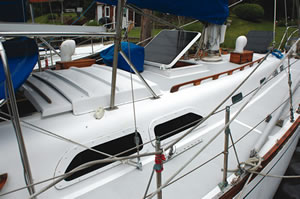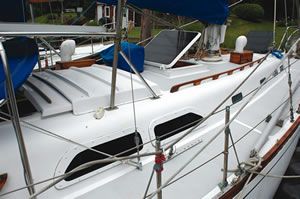
288
Our on-the-water testing backed up our panel test results, but also drove home some valuable surface preparation feedback. The key focuses of our testing on a dinghy, a Cape Dory Typhoon daysailer, an Ericson 41 cruiser, and a Catalina 22 were on nonskid painting and cabin and topside finishes.
Among the most significant findings of our real-world experimenting was that single-part modified urethane topside coatings, such as Interlux’s Brightside, can also serve as durable deck coatings.
In one application, we used Interlux Brightside Kingston gray to paint a cockpit sole, which meant it had to endure scuffing, plenty of water accumulation, and baking sunlight. For the daysailer deck-paint job, testers used Pettit EasyPoxy in pearl gray; nearly three years later, the finish is still going strong.
When we compared these finishes with the two-part Interlux Perfection nonskid paint job aboard the Ericson 41, the tougher two-part paint had a shinier, better sealed appearance, but the mono-urethanes—after three seasons—still had some life left.
When compared with the two-part Awlgrip topside spray job on the dinghy, brushed Brightside is just not as glossy, but that’s just as we’d expect: The less brilliant gloss teams up with the less-than-brilliant brushing technique of most amateurs to give just the right amount of reflective appeal.
The same can be said of the topside finish on our Catalina 22, Jelly. Testers used the roll-and-tip method to apply two-part LPUs to its hull (PS, August 2009): Interlux Perfection Mediterranean White on the starboard side and Epifanes Poly-urethane No. 800 white on the port. After a year and a half of constant exposure to the Florida weather, there has been no loss of gloss and no adhesion issue. Both paints still look good and glossy, but close-up inspection reveals that the Epifanes is a bit shinier. However, the challenges testers had in applying it are evident in the still-visible sags and holidays.
Surface Prep
The importance of surface prep and how well the paint anchors to the substrate cannot be overstated, especially when using a two-part LPU. In part of our testing, we used a pro shortcut often referred to as “hot coating” to apply the two-part Awlgrip.
This entails applying a epoxy primer—after a very careful surface prep—with as much attention to detail as the topcoat. Just as the primer flashes and is in the primary stage of its cure (about an hour in warm weather), you overcoat with an LPU and allow the same timeframe for solvents to escape and the paint to skin cure. Then, the second and final LPU coat is applied.
This routine is used on flat areas such as the tricky waterway where the deck leads into the toerail, or in other sections between flat regions of nonskid. Gravity helps the self-leveling process, and paint build up can be amassed in a very short time.
In the four years since this approach was used on our technical editor’s Ericson, there has been little loss of gloss and no sign at all of any adhesion issues. The success stems from having an 80-grit sanded surface for the epoxy primer to grab onto, and then chemically linking the LPU paint to the still “green” epoxy undercoat. Trying to control the flow of this much paint on a vertical surface is too challenging, and hangs and sags will ruin the day.




































